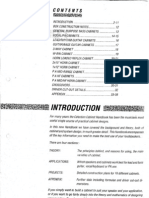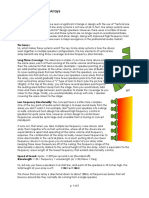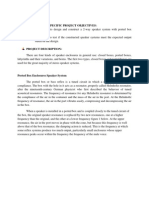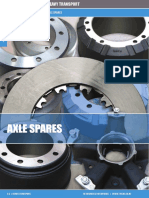Car Speaker Enclosure Design - MTX Audio - Serious About Sound®
Car Speaker Enclosure Design - MTX Audio - Serious About Sound®
Uploaded by
drip2hardadedCopyright:
Available Formats
Car Speaker Enclosure Design - MTX Audio - Serious About Sound®
Car Speaker Enclosure Design - MTX Audio - Serious About Sound®
Uploaded by
drip2hardadedOriginal Title
Copyright
Available Formats
Share this document
Did you find this document useful?
Is this content inappropriate?
Copyright:
Available Formats
Car Speaker Enclosure Design - MTX Audio - Serious About Sound®
Car Speaker Enclosure Design - MTX Audio - Serious About Sound®
Uploaded by
drip2hardadedCopyright:
Available Formats
MY ACCOUNT LOG OUT (0)
Search GO
Car Speaker Enclosure Design
When a speaker moves forward, air in front of the cone is compressed. At the same time,
air in back of the cone is rarefied (stretched). If there is a pathway for the compressed air
to get behind the cone, it will do so. This process reduces the amplitude of the soundwave.
It is therefore necessary to use some type of enclosure, in order to keep the soundwaves
from cancelling each other out.
Infinite Baffle
An infinite baffle design is defined as an enclosure that contains a greater volume of air
than the Vas of the driver. An infinite baffle system can easily be applied to an automobile.
This is accomplished by mounting the speakers on a board and using the trunk of the
vehicle as the other walls of the enclosure. It is important that there be no leaks that would
allow air to move from the front to the back of the cone. Look for speakers where the Qts
is greater than .6, and a Vas lower than the volume available when selecting a woofer for
an infinite baffle system.
Sealed Enclosures
When the volume of air within a sealed enclosure is less than the Vas of the
driver, the air trapped within the enclosure acts as an acoustic spring that Diagram 1 - Sealed Enclosure
adds to the restoring force of the speaker. This system is called acoustic
suspension, also referred to as a sealed enclosure. Acoustic suspension
systems are relatively easy to design and construct. The output rolls off at
12dB per octave below the point where output is down 3dB from midband
(F3). A well designed sealed enclosure will exhibit smooth frequency
response with excellent cone control at sub-bass frequencies. When
selecting a woofer for a sealed enclosure, look for Qts to be between .3 and
.9, with a low Fs (below 40Hz).
Vented Enclosures
Vented enclosures are also known as ported, bass reflex, tuned, or tuned
Diagram 2 - Vented Enclosure ported. A vented enclosure is essentially a sealed enclosure with an extra
opening that allows the back wave to interact with the front wave. By
changing either the length or surface area of the opening, we change the
tuning frequency of the enclosure.
This system offers some performance advantages and disadvantages over
a sealed enclosure. The advantages are, for a given enclosure volume,
deeper bass extension or higher output. Another advantage is that near the
tuning frequency, almost all output is from the vent so cone movement is
controlled to the point of almost no movement. The disadvantage is that
below the tuning frequency, the speaker no longer has the restoring force of the air in the
enclosure, and therefore the cone acts as though it is in free air.
When selecting a woofer for a vented enclosure, look for speakers with a Qts in the range
of .1 to .40, as well as a relatively low Fs (30-40 Hz).
Bandpass
The bandpass systems, also referred to as 4th, 5th, 6th,
7th,8th... order enclosures can best be described by referring Diagram 3 - Single Reflex Bandpass
to them as single or dual reflex.
A single reflex system has one side of the speaker in a sealed
enclosure and the other side in a vented enclosure. The
benefits of this type of system are controlled cone excursion
at low frequencies, and the ability to sacrifice efficiency for
deeper bass or vice versa. The frequency response of the
single reflex system is controlled by the enclosure volumes
and tunings.
Due to the fact that all the sound from this type of enclosure
is produced by the vent, sound quality may not be as good as
that of a properly designed sealed or ported enclosure.
However, there are times when bandpass enclosures are the
best choice to use. In a sedan application, bandpass
enclosures are often used due to the inability to have multiple
drivers mounted in the rear deck. In a limited space situation, efficiency can be sacrificed
to gain deeper bass extension. In a situation where ultimate SPL is the goal, you can
sacrifice bass extension, and enclosure size to produce a very efficient enclosure.
Efficiency gains in the range of 5-10dB are not uncommon! As with any enclosure design,
there is no free lunch. As you change one parameter to gain another, many times sound
quality is degraded as well.
The frequency response in the pass band of a single reflex enclosure can
Diagram 4 - S values be described with an “s factor”. S values that are of interest to us fall
between .7 and .4. Values beyond this range either have peaky response,
or poor sonic quality. An s of .7 refers to the flattest pass band available,
where an s of .4 refers to the widest useable pass band.
A dual reflex enclosure can be described as a speaker with a ported
cabinet on both sides. This system has the advantage of making use of
both the front and the back wave of a speaker, and can attain great
efficiency. However, like a vented enclosure, when operating below the
tuning frequency of the enclosure, the driver may move beyond its
excursion limitations. Combine this with the fact that all information is
produced by the ports, so, we can’t hear the distortion until it is too late.
Multiple Drivers
Diagram 5 - Dual Reflex Bandpass
It is often possible to attain better sound quality and higher
output for a given airspace by using multiple smaller
speakers rather than a single large one.
When designing an enclosure that will use multiple speakers,
be sure that you are doubling the air space that you would
have used for a single driver. If the speakers will be given the
same signal, a divider is not necessary. If the speakers will be
operated by two different signals, be sure to use a divider to
separate the two enclosures, or cancellation will result.
Isobaric
Diagram 6 - Multiple Driver Enclosure
By combining two woofers to act as one, either by mounting
them gasket to gasket, or gasket to magnet or magnet to
magnet, we create an isobaric system. An isobaric system acts
as one speaker, but requires an enclosure volume that is half of
what one singular driver would take. The output capability of this
system is limited to what a single speaker would be in a cabinet
of twice the size of the isobaric system. The reason that an
isobaric system requires only half of the enclosure volume is that the Vas is half of the
single driver. This is due to having two suspensions on the same diaphragm.
The halving of enclosure size does come at a cost. The isobaric
system is 3dB less efficient than that of a single driver in an enclosure Diagram 7 - Multiple Driver Enclosure
of twice the size. This means that to get the same output as one
driver, you must double the applied power. Providing that you have
enough power, two isobaric systems, which would take up the same
amount of space as one single woofer, would have 3dB more output
due to the increase in cone area. This can be used to your advantage
when standard enclosures will not give enough SPL, by quadrupling
the input power and quadrupling the number of drivers, you can attain
6dB more output.
Share this MTX page...
Follow Us
800-225-5689 / Support
Privacy | Terms | ISO 9001:2015 Certification | Contact Us | About Us
Copyright © 2023 MTX Audio. All rights reserved.
You might also like
- Small Antennas ReviewDocument10 pagesSmall Antennas Reviewsudoworld2001No ratings yet
- Java wsd18 Operating Instructions ManualDocument18 pagesJava wsd18 Operating Instructions Manualjose luis peralesNo ratings yet
- Tutorial: Enclosure-Type Performance Comparision: Sub-30Hz BehaviorDocument3 pagesTutorial: Enclosure-Type Performance Comparision: Sub-30Hz BehaviortinguiblueNo ratings yet
- A Guide To SubwoofersDocument32 pagesA Guide To Subwoofersclimber078360No ratings yet
- JBL Subwoofer - CS1204 (English)Document4 pagesJBL Subwoofer - CS1204 (English)pimpf1No ratings yet
- TypesOfSubEnclosuresDocument3 pagesTypesOfSubEnclosuresDavid WildeNo ratings yet
- Downloaded From Manuals Search EngineDocument7 pagesDownloaded From Manuals Search EngineHigor FelipeNo ratings yet
- Kappa Perfect 10 Manual NON-VQDocument6 pagesKappa Perfect 10 Manual NON-VQmjam100No ratings yet
- 960038aktiv Subwoofer Part 1Document4 pages960038aktiv Subwoofer Part 1Christopher QuadrosNo ratings yet
- Enclosure TutorialDocument13 pagesEnclosure TutorialLuis Bernardo Choque Sallama50% (2)
- Oxford SuprEsser ManualDocument34 pagesOxford SuprEsser ManualaaaNo ratings yet
- 1978 - Loudspeaker System Design - Three-Enclosure System With Active Delay and Crossover (Linkwitz)Document16 pages1978 - Loudspeaker System Design - Three-Enclosure System With Active Delay and Crossover (Linkwitz)ettorreitNo ratings yet
- GRAND TOURING GT 100, GRAND TOURING GT 100D, GRAND TOURING GT 120, GRAND TOURING GT 120D, GRAND TOURING GT 150, GRAND TOURING GT 150D JBL OmDocument4 pagesGRAND TOURING GT 100, GRAND TOURING GT 100D, GRAND TOURING GT 120, GRAND TOURING GT 120D, GRAND TOURING GT 150, GRAND TOURING GT 150D JBL OmbetoarmaxNo ratings yet
- JBL p1222 Manual de UsuarioDocument4 pagesJBL p1222 Manual de UsuarioLio SnNo ratings yet
- Simple Infinite Baffle Mounting BoardDocument14 pagesSimple Infinite Baffle Mounting BoardAlan Gamboa0% (1)
- 2 Vias - MetaphorDocument11 pages2 Vias - MetaphorAlberto PereiraNo ratings yet
- GTi W12 MkII OM EN PDFDocument8 pagesGTi W12 MkII OM EN PDFHiram SandovalNo ratings yet
- ELX 3 Week 4 and 5Document13 pagesELX 3 Week 4 and 5Nicole Ann ParmaNo ratings yet
- GTO1014 GTO1014D GTO1214 GTO1214D GTO1514 GTO1514D: Grand Touring SeriesDocument4 pagesGTO1014 GTO1014D GTO1214 GTO1214D GTO1514 GTO1514D: Grand Touring SeriesErnani JúniorNo ratings yet
- Car Audio Glossary of TermsDocument4 pagesCar Audio Glossary of Termsbulux2008No ratings yet
- 2 Vias-EgoDocument10 pages2 Vias-Egoleonardo osmelNo ratings yet
- 2 Vias - Metaphor PDFDocument11 pages2 Vias - Metaphor PDFleonardo osmelNo ratings yet
- Designing Spkrs Pt4tlDocument3 pagesDesigning Spkrs Pt4tlpavanakrithiaudiosNo ratings yet
- Cabinet HandbookDocument38 pagesCabinet Handbookxavierchocula100% (6)
- Danley TappedDocument8 pagesDanley TappedmenombreesdanielNo ratings yet
- Loudspeaker and Audio MonitorsDocument21 pagesLoudspeaker and Audio MonitorsPraveen SehgalNo ratings yet
- Speaker)Document11 pagesSpeaker)inhinyerokinoNo ratings yet
- Reverb Block - Fractal Audio Wiki PDFDocument12 pagesReverb Block - Fractal Audio Wiki PDFNikko Rafael NoblezaNo ratings yet
- EAW - KF760 Technology OverviewDocument14 pagesEAW - KF760 Technology OverviewmolinsonNo ratings yet
- Ms12sd4 Om enDocument12 pagesMs12sd4 Om enamal baik gintingNo ratings yet
- Understanding Line Arrays: by Mark HartshornDocument2 pagesUnderstanding Line Arrays: by Mark HartshornEl Iimperio 73No ratings yet
- University 1963 p2Document9 pagesUniversity 1963 p2alessandrocicchinelli81No ratings yet
- GTC Brochure PUB 890901Document4 pagesGTC Brochure PUB 890901gracy2288No ratings yet
- Power Bass s124Document16 pagesPower Bass s124andrejko2No ratings yet
- LineArrays WhitePaperDocument14 pagesLineArrays WhitePaperAlenMomirovićNo ratings yet
- JBL VLA Variable Line Array White PaperDocument21 pagesJBL VLA Variable Line Array White PaperSound Technology LtdNo ratings yet
- Information Sheet Lsim SeriesDocument4 pagesInformation Sheet Lsim SeriesjimmymacbootNo ratings yet
- The TributesDocument8 pagesThe TributesbobannesicNo ratings yet
- SpeakersDocument21 pagesSpeakersdjpatrickapostolNo ratings yet
- Types of SpeakersDocument5 pagesTypes of SpeakersDavid PeterNo ratings yet
- Audio CrossoverDocument8 pagesAudio CrossoverDwtwo Juliet EchoxràyNo ratings yet
- Bi-Amplified Studio Reference Monitor: Quick Start Owner's ManualDocument82 pagesBi-Amplified Studio Reference Monitor: Quick Start Owner's ManualhugocomunicaNo ratings yet
- Loudspeaker Technical Specifications Guide v3.0Document7 pagesLoudspeaker Technical Specifications Guide v3.0Badea SorinNo ratings yet
- Acoustic Measurement TipsDocument6 pagesAcoustic Measurement TipsIrfangiNo ratings yet
- SAE Institute - LoudspeakersDocument8 pagesSAE Institute - LoudspeakersSequeTon Enlo100% (1)
- Ported Box Enclosures Speaker SystemDocument13 pagesPorted Box Enclosures Speaker SystemSubaru_10167% (3)
- Unobtrusive Audio: Current Trends and Design Considerations: KEF Audio (UK) LTD, Maidstone, UKDocument5 pagesUnobtrusive Audio: Current Trends and Design Considerations: KEF Audio (UK) LTD, Maidstone, UKcamt2112No ratings yet
- Cardioid Subwoofer Arrays SettingsDocument6 pagesCardioid Subwoofer Arrays SettingsjuantagororNo ratings yet
- The Loudspeaker Spec Sheet, John M. RischDocument7 pagesThe Loudspeaker Spec Sheet, John M. RischThomas GrantNo ratings yet
- Basic Sonar System (Active) PDFDocument18 pagesBasic Sonar System (Active) PDFthejerskiNo ratings yet
- CS 1214 Om enDocument4 pagesCS 1214 Om enCiro De SouzaNo ratings yet
- A Few Words About Intermodulation Dynamic Range and Roofing FiltersDocument6 pagesA Few Words About Intermodulation Dynamic Range and Roofing Filtersstanpjames2309No ratings yet
- Convolution Techniques PDFDocument4 pagesConvolution Techniques PDFSimon ScarazzonNo ratings yet
- Biamp Design Guide Desono EntasysDocument56 pagesBiamp Design Guide Desono EntasysDaniel AndoziaNo ratings yet
- uxp10dDocument12 pagesuxp10dRicardo ZimmerNo ratings yet
- Meyer Pp-LinaDocument14 pagesMeyer Pp-LinaAVteck AvteckNo ratings yet
- TUTORIAL For The HANDBOOK FOR ACOUSTIC ECOLOGYDocument52 pagesTUTORIAL For The HANDBOOK FOR ACOUSTIC ECOLOGYTaner ÖNGÜNNo ratings yet
- Insertion Loss in Bandpass CavitiesDocument3 pagesInsertion Loss in Bandpass CavitiesDuy ĐặngNo ratings yet
- DIY Speaker EnclosuresDocument4 pagesDIY Speaker EnclosuresRedmi 3s100% (2)
- Oxford Reverb ManualDocument17 pagesOxford Reverb ManualaaaNo ratings yet
- Flow Switches: BFS-40-N / BFS-40-O BFS-40-N / BFS-40-ODocument2 pagesFlow Switches: BFS-40-N / BFS-40-O BFS-40-N / BFS-40-ODragan LazicNo ratings yet
- 5 TQM - JitDocument26 pages5 TQM - JitBob BinNo ratings yet
- MA900/MA901: Instruction ManualDocument22 pagesMA900/MA901: Instruction ManualAnh HuânNo ratings yet
- Course No: CAP616T Course Title:: Computer GraphicsDocument4 pagesCourse No: CAP616T Course Title:: Computer GraphicsAman LobanaNo ratings yet
- Public Space Acupuncture PDFDocument54 pagesPublic Space Acupuncture PDFJesus Ocampo TelizNo ratings yet
- Irjet V3i7176 PDFDocument5 pagesIrjet V3i7176 PDFanon_789699787No ratings yet
- Automation of Cars in Embedded SystemsDocument10 pagesAutomation of Cars in Embedded SystemsVijetha YadlaNo ratings yet
- Research Methodology 2Document10 pagesResearch Methodology 2Mihir DesaiNo ratings yet
- Overall CCTRDocument182 pagesOverall CCTRInaam Ullah Mughal100% (2)
- Project Close Out Survey TemplateDocument6 pagesProject Close Out Survey Templatekhanhdang1214No ratings yet
- 2013 Isuzu Truck: Weight Distribution ConceptsDocument30 pages2013 Isuzu Truck: Weight Distribution ConceptsHassan Shathak100% (1)
- KB 4920 TX - Drawing PDFDocument1 pageKB 4920 TX - Drawing PDFhugoheloNo ratings yet
- DMA Paper FinalDocument82 pagesDMA Paper FinalTracy WigginsNo ratings yet
- Chapter - 3 - Entrepreneurship, Franchising and Small Business Part-1Document17 pagesChapter - 3 - Entrepreneurship, Franchising and Small Business Part-1anon_952991112No ratings yet
- Semi - Detailed Lesson Plan in Oral Communication in Context (CCS Integration)Document1 pageSemi - Detailed Lesson Plan in Oral Communication in Context (CCS Integration)Ja LascanoNo ratings yet
- Cyberpunk Guns 3 Shotguns and RiflesDocument46 pagesCyberpunk Guns 3 Shotguns and RiflesFuzzaMan100% (1)
- ZF Actuator PDFDocument40 pagesZF Actuator PDFMATIAS100% (4)
- Catalysts Licensing One Pager EnpdfDocument2 pagesCatalysts Licensing One Pager Enpdfprasad336No ratings yet
- Temperature ControlDocument11 pagesTemperature ControlTasawwur TahirNo ratings yet
- Nitol Curtis Paper Mills LTD.: Invoice/BillDocument1 pageNitol Curtis Paper Mills LTD.: Invoice/BillMd. Tanvir RahmanNo ratings yet
- ECSxK Capacitor v1-0 enDocument40 pagesECSxK Capacitor v1-0 enabrahanlNo ratings yet
- Xarios 350 EngDocument2 pagesXarios 350 EngahszarNo ratings yet
- Tete Precitec 1638883537Document2 pagesTete Precitec 1638883537muhittincakirrrrNo ratings yet
- A01 Heavy Trailer Axle SparesDocument33 pagesA01 Heavy Trailer Axle SparesFernando Padilla100% (1)
- Examples On Triggers: Instructor: Mohamed Eltabakh Meltabakh@cs - Wpi.eduDocument15 pagesExamples On Triggers: Instructor: Mohamed Eltabakh Meltabakh@cs - Wpi.edurohit hedauNo ratings yet
- Integrated Fuel System Specification ©Document3 pagesIntegrated Fuel System Specification ©johnny sabinNo ratings yet
- A Research Project OnDocument4 pagesA Research Project OnDaman Deep Singh ArnejaNo ratings yet
- Kinematic of MechanismDocument12 pagesKinematic of MechanismFennyFebrinaNurlitaSariNo ratings yet
- Lighting CalculationDocument6 pagesLighting CalculationMohd Helmy Hakimie RozlanNo ratings yet

























































































